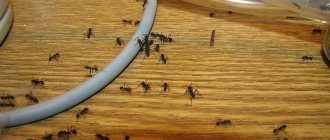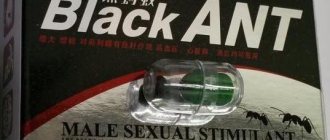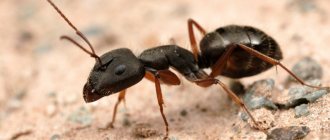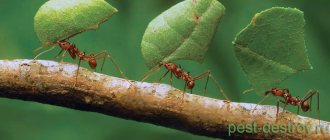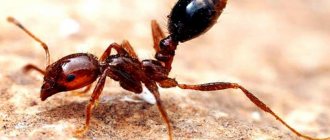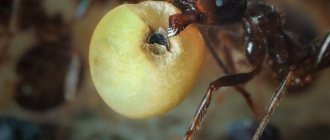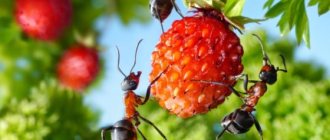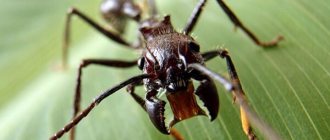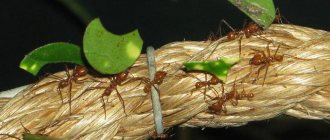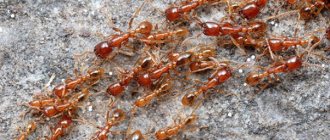Description of the species
Lasius niger ants prefer to live in a large colony, the number of which can reach several thousand individuals.
The main thing in the anthill is the uterus. She is also the largest individual. The queen of black ants can reach 1 cm in length. The size of the working insect is up to 5 mm. The female is slightly shorter in length than the male. Its size does not exceed 4.5 mm, and the male grows up to 5.5 mm. The color of individuals ranges from dark brown to deep black. The entire body of the insect is covered with very short hairs. Large black ants choose garden plots, tree trunks, hollows, and stumps as habitats.
Interesting!
The queen of this species can live for about 28 years.
Small invertebrates serve as food for insects, but most of all ants prefer to eat sweet honeydew, which is secreted by aphids.
Major pests
Wooden houses are often inhabited by three types of wood ants: red-breasted, black and odorous. Other carpenter ants can also live in walls, but these ones, due to their omnivorous nature, appear directly in living quarters and are easy to notice.
The largest carpenter ant
Red-breasted carpenter ants
The red-breasted carpenter ant is the largest of all insects of the family living in Russia. Red-breasted carpenter ants can reach 2 cm in size.
An ant can live not only in dead trees, but also gnaw through living wood. Well-dried logs, used for the construction of walls in a wooden house, are not a barrier for this insect. This ant does not feed on wood. It gnaws holes in trunks and log walls, making its nest there. Red-breasted woodborers live in colonies, the number of which can reach 10 million individuals. By gnawing holes in a tree, these insects are capable of making one shell with a rotten core from a high-quality solid log within a year.
Having settled in the house, red-breasted woodborers look for food indoors. Like other ants, red-breasted carpenter ants pick up leftover food in the kitchen and are very greedy for sweets.
Females and males of this species have wings and can migrate a considerable distance in search of a place for a new nest. Working individuals of all castes are wingless.
Black wood borer
Black wood borer
Outwardly similar to the black garden ant, but differs in its large size and very large head. Females and soldiers of this species reach 1.5 cm in length. The head of the black woodworm is wider than the abdomen.
The black carpenter ant lives in rotten wood of forest trees. It rarely attacks houses, since there is no suitable habitat for it. But if the house begins to rot, you can expect ants to appear. When planning to fight this species, you need to take into account that in the Vladimir and Vologda regions these insects are included in the Red Book.
Smelly guest
Odorous carpenter ants
The validity of the name of this species is disputed. They say that the odorous carpenter ant got its name from its pungent “non-ant” smell. But inquisitive researchers, poking around in the anthills of these insects, did not notice any smell.
Odorous carpenter ants are a small species of ant and can easily be confused with common black ants. The odorous one also has a black body color, but a larger head and abdomen with light stripes. But the latter is visible only with magnification.
The size of females of this species is 8 mm, males 4 mm and workers 4-5 mm. There can be several females in one colony.
Scented woodworms feed on the honeydew of aphids, which they breed in their anthills. Nests are made in hollow trees, chewing rotted wood to the state of very fine sawdust and gluing the resulting mass with saliva. When finished, the building material looks like “cardboard”, similar to that made by distant relatives of ants – wasps.
Shiny carpenter ant
Shiny carpenter ant
Insects of medium size: females 1 cm, males 0.7 cm, workers 0.5-0.9 cm. Body black, shiny. The head is large.
Lives in dead wood and living trees. In nature, it hunts small invertebrates and collects aphid honeydew. The diet of this carpenter ant is protein-carbohydrate, so having chosen a wooden residential building as a nest, the insects will begin to pick up leftover food from a person’s table.
Features of the system
The life of lasius niger is to provide the uterus with basic nutrients. Each group of individuals has its own responsibilities:
- breeding offspring;
- anthill protection;
- food production.
The lifespan of females is significantly longer than males. Males die almost immediately after mating. Therefore, the average life of a male lasts no more than a month, and a female lives up to 1 year.
There can only be one queen in one anthill. Sometimes a larger number is possible at an early stage of colony development. Afterwards, the flying females themselves fly out of the anthill, look for places to lay eggs and create their own colony. You can see the differences even by looking at a photo of black ants. Females and males have wings; workers do not have them. The queen initially also has wings, which she later chews off herself.
Big black ants in the garden
Interesting!
Fertilization of the female garden ant occurs during the mating flight.
The larva of this type of ant is a sedentary worm with a whitish color. After reaching the required age, nurse ants help new individuals to be born. They break the egg.
Professional services
If traditional methods do not lead to a positive result, you should turn to professionals.
Experts will ensure quick and effective removal of black ants, as they have great capabilities to eliminate them.
This method is good if you have the opportunity to leave the apartment for several days in order not to be exposed to toxic substances and chemicals.
Professionals completely treat every area in the room with special solutions, from which black ants die instantly.
IMPORTANT: Insects can return to the apartment again if they live with your neighbors. Therefore, it is necessary to fight against black ants through the joint efforts of all owners of adjacent apartments
Black carpenter ant (Camponotus vagus): distinctive features
Black carpenter ant (Camponotus vagus), appearance
An insect can be identified by color and size. Despite this, representatives of this species are often confused with other ants that live in forests. The insect also has an extremely similar physique to its close relative, the red-breasted carpenter ant.
External characteristics
The black carpenter ant (Camponotus vagus) is large in size: the body length of females is 1.5-1.7 cm, soldiers are slightly smaller than females, males are 1-1.2 cm, workers are 0.6-1.3 cm The color is black, shiny, without any admixtures of other shades. The antennae are geniculate. The eyes are medium-sized, black. The head is large and wide. There are light silvery hairs on the abdomen. The lower edge of the clypeus is straight.
The eggs are small and have an elongated shape. The color is white, often with a slight hint of yellow. Insect larvae have pronounced segmentation. The body color is similar to the eggs. The body is shiny, translucent.
Spreading
The black carpenter ant lives exclusively in forests. This insect can be found in Europe and Northern Asia: in the Crimea, Western Siberia, Kazakhstan, Turkey, the Urals, and the Caucasus. It also lives in northwest Africa.
Under unfavorable conditions, ants hide in underground passages. They prefer deciduous trees. The largest populations are seen in places with high humidity.
Morphology
Imago. Body size – 16–18 mm. The abdomen is matte, completely black or with a small reddish spot at the base. The chest is dark or brownish red. The scales and legs are red. Like all representatives of the ant family, the clypeus is clearly distinguished on the head, behind it is the frontal platform, and on the sides of the platform are frontal ridges. The antennae are twelve-segmented, articulated at the frontal carina at a considerable distance from the posterior edge of the clypeus. The clypeus is convex, with a rounded anterior edge. The antennal and clypeus pits are separate and unconnected. The chest in profile is uniformly convex, without depression. Epinotupe without spines and teeth. The red-breasted carpenter ant has mandibles with 4–5 teeth, the clypeus does not protrude forward. The cheeks are without hair-bearing pits; the clypeus has only two pits near the anterior edge.
Female. Size – 15–18 mm. Winged only during mating flight.
Male. Size – 9–11 mm, black, winged. Life expectancy is short.
The workers are large – 6–14 mm, with a massive, wide, almost square head and a high, dense chest. Always wingless.
Egg. Like all representatives of the ant family, the eggs are white, small, round in shape, 0.1–0.8 mm long. The integument is thin, delicate, almost transparent, white or slightly yellowish. Newly laid eggs are microscopically small and individually not visible to the naked eye. But you can notice them because they are collected in packages.
Larva. Like all members of the family, the larvae after hatching are small, 0.2–0.5 mm long, almost oval, whitish or yellowish. The body is worm-shaped, almost naked, consists of a head, three thoracic and ten abdominal segments, sharply narrowed in the first quarter, hook-shaped. The antennae are not developed and are represented by small rounded tubercles. No eyes. The oral organs consist of small mandibles narrowed at the ends, even less developed jaws and a lower lip.
Lifestyle of black carpenter ants
The nests of black carpenter ants are most often located in rotten tree stumps. Sometimes Camponotus vagus can be seen in hollows and wooden buildings. Like other members of the family, these ants live in large colonies. All individuals are divided into groups depending on their responsibilities:
- builders;
- hunters;
- nannies;
- soldiers;
- females;
- males.
Most arthropods belong to the first 3 groups. The lifespan of females is up to 28 years. Males live the shortest - they die immediately after mating. Apart from them, hunters have the shortest life expectancy, who rarely live up to 3 years.
The black carpenter ant is active during the daytime. Rarely leaves the shelter in cloudy weather. The only ones who are active at any time of the day are the soldiers. Among all the worker ants, the most common are builders.
Reproduction
Females and males capable of mating make up only a small part of the offspring. In the spring, at the end of April - beginning of May, they leave the anthill and go in search of partners. These individuals have wings, thanks to which they can move long distances. Mating occurs in the air. The fertilized female is looking for a place suitable for building a new anthill. There she chews off her wings, and her activity noticeably decreases.
The queen raises her first offspring on her own. One female mating is enough for the rest of her life. Thus, after the first offspring becomes adults, the female stops leaving the anthill. Nurses help the queen take care of subsequent larvae and eggs. However, the female still makes a large contribution to caring for the offspring.
Benefits and harms of insects
Although ants are small in size, they can cause a lot of harm. By raiding food products, they can seriously spoil them. If the house is wooden, ants can settle inside the walls, gnawing out passages there. Personally, they can cause a lot of trouble for a person, sneaking into bed at night and interfering with sleep. Yes, and they bite noticeably. The benefits of ants in the house are questionable: they can only clean up crumbs and leftover food from the floor after you. So if you find these insects in your home, you should not hesitate to destroy them.
Use of boric acid
Boric acid is used to combat various insects, including carpenter ants. To do this, mix it with sugar in a 2:1 ratio. The resulting mixture is laid out in small dishes and placed around the nest. Ants go for sugar, and boric acid enters the body with it. It dissolves the insect from the inside. Working individuals bring boric acid into the nest. This way it will get to the females and other inhabitants, destroying them.
Nutrition
Large black ants in the garden find food for themselves, their larvae. Adults feed on plant juices, a sweet secretion secreted by aphids. To obtain food, ants spread aphids throughout the garden, providing them with the most succulent trees in the country. Behind it they collect honey dew.
Ants' habitat
Interesting!
Black ants keep aphids in their home in a special chamber. They provide her with adequate nutrition, tickle her with antennae, and receive a sweet delicacy.
The larvae are more voracious. They need protein foods. Adults bring them insects, worms, and slugs. These feeding habits make black garden ants useful and harmful. Insects will destroy small pests and spread aphids themselves, causing significant damage to crops.
What inconveniences do they cause?
Damage from ants
The appearance of black ants at the dacha causes a lot of trouble. After all, these insects bite very painfully. When the skin is punctured, they release a special substance that causes itching and burning.
Lasius niger ants also have a negative impact with their vital activity in the following cases:
- Eating crops. Large black ants in the garden readily feed on strawberries, wild strawberries, potatoes and many other crops. A huge colony can destroy a large amount of crops over the entire summer period.
- Increased soil acidity. The garden ant leaves its waste products on the beds, as a result changing the composition of the soil. This fact negatively affects plant growth.
- Deterioration of crop growth. You can often find a nest of ants right in the roots of garden plants. This seriously weakens cultures and inhibits their development.
- Spread of pathogenic bacteria. Garden black ants have direct access to human food, because they can easily get into the house. Insects carry bacteria that can lead to infection with typhoid, diphtheria, salmonellosis and other dangerous diseases.
Black ants pose the greatest danger to small children and pets. Trying to protect their own queen, they can seriously bite the victim and cause discomfort.
Behavior
The garden black ant is a non-aggressive creature, but endowed with a sting with poison. They use their weapons during hunting, when enemies attack, or when danger approaches. The insects bite quite hard, leaving an inflamed red mark. For a person prone to allergies, an ant bite can cause serious health problems.
Interesting!
There are always several adults guarding order. In case of danger, they give a signal to the others and attack the enemy en masse. In an instant, a whole colony of insects appears on the foot of a person who steps next to an anthill.
An insect will not just bite. He will crawl freely along his arm and leg if he is not in danger. The slightest pressure on the body leads to a defensive reaction.
On a note!
In nature, there are a huge number of giant black ants that can bite domestic animals to death and cause significant damage to human health. This type of ant lives in tropical countries. When insects infest, residents leave the house, taking their entire household with them.
Tired of fighting pests?
Are there cockroaches, mice or other pests in your dacha or apartment? We need to fight them! They are carriers of serious diseases: salmonellosis, rabies. Many summer residents are faced with pests that destroy crops and damage plants.
In such cases, our readers recommend using the latest invention - the Pest Reject repeller.
It has the following properties:
- Gets rid of mosquitoes, cockroaches, rodents, ants, bedbugs
- Safe for children and pets
- Powered by mains, no recharging required
- There is no addictive effect in pests
- Large area of operation of the device
Read more about it here >>
Sprays and aerosols
Sprays and aerosols are effective in killing ants.
They have a number of advantages:
- safety for others;
- active chemicals;
- quick and high-quality disposal of domestic insects.
The disadvantages include:
- high cost (from 120 rubles and above);
- sedimentation of substance particles on interior items and indoor plants;
- strong and unpleasant odor (may cause allergies or headaches, nausea and vomiting).
Among the common types of sprays and aerosols:
- Raptor;
- Combat;
- Clean house;
There is no difference between domestic and foreign producers. They are equally effective. After using sprays and aerosols, it is recommended to wash your hands thoroughly, tightly close the release hole of the substance, and store the container in a dark and dry place away from fire sources, children and animals.
Let's celebrate! Such products can be used after 3-4 months have passed from the date of the last treatment. It is also recommended to read the instructions on the back of the cylinder before use.
Habits of black ants
Black ants love warmth, and therefore make their homes in stumps well warmed by the sun. Like other forest ants, they are busy working from morning to evening. They are more active during the warm part of the day. In the morning hours they are slow because they are cold. At night, the entire anthill falls asleep, only large soldiers crawl on the stump. Small individuals perform all the work associated with the uterus and its larvae. Soldiers gnaw wood, get food, and protect the house. Underground tunnels save ants in bad weather. At this time, all external work is completed.
Insect housing
An arboreal arthropod builds a nest inside a dry tree, an old stump. You can always see the presence of small holes - entrances and exits, and sawdust near the nests. Their type and quantity makes it possible to determine the age of construction, as well as the number of individuals in the colony. It is worth noting that such an anthill can serve as an excellent landmark for a lost traveler.
Individuals are always working here. Woodworms of various sizes can be found near their home. For example, soldiers are distinguished by the presence of a large head, their body is no more than three millimeters long, and are characterized by slowness and caution. The soldiers perform the function of observing what is happening, assessing the safety of the situation. The smallest representatives are working individuals.
The working clan is engaged in the process of building a house, every day they increase the number of tunnels, passages and chambers underground. It is worth noting that at night insects sleep, but not guard soldiers. Speaking about the winter period, in cold weather all movement occurs only underground in the created passages.
Why is the black carpenter ant dangerous?
The carpenter ant is useful for nature: it cleans forests of small parasites and fungi, and also loosens the soil, but for humans the ant can be a pest.
The insect reproduces quickly and is unpretentious to living conditions. Carpenter ants do not feed on wood. It makes tunnels in it, reducing the strength of the material and promoting rot. It is important to know that the black carpenter ant often damages supporting structures near the base. This creates a risk of the building collapsing.
Like other types of ants, the black carpenter ant can bite humans. Although such a bite does not pose a significant threat, it can cause an allergic reaction. It manifests itself especially often in young children.
Allergy symptoms most often include:
- nausea;
- labored breathing;
- pale skin;
- tachycardia;
- dizziness.
Camponotus vagus are quite aggressive ants. Their bites are extremely dangerous for newborns.
It is also important to consider that the black carpenter ant is a carrier of many diseases. Infection can occur through any objects that have been visited by pests.
Carpenter ants can carry the following diseases:
- salmonellosis;
- helminthiasis;
- dysentery;
- cholera;
- typhoid fever.
Rarely does an insect cause diphtheria infection.
The carpenter ant poses a serious threat not only to people, but also to pets. It can carry such dangerous diseases for animals as parvovirus enteritis.
The pest often damages food. It is important to understand that eating such food is unacceptable. This is justified not only by the low nutritional value and lack of useful elements, but also by the extremely high risk of infection by diseases carried by the carpenter ant.
Signs of infection
Black carpenter ants are fairly easy to spot because they do not hide and are most active during the daytime. In addition, insects constantly follow certain routes and always move in large groups. In places where ants create tunnels, wood dust remains.
Reasons for appearance
Ants appear in a wooden house very often - much more often than we would like. There are two main factors - one insect needs to find food provided by humans, but large wood ants feed on the house itself, its main structures. Pharaoh ants move into houses if:
- the original anthill is located nearby or in adjacent rooms;
- cleaning is done too infrequently;
- pests were brought in accidentally, for example, with purchases or with planting material (dug up soil);
- insects are fleeing from some danger and looking for a new shelter where they could settle.
Often large (or small) ants settle in neighbors' village homes. There is nothing surprising in this: when the house is close to the original settlement, the increase in the population size forces the ants to “open branches” within a certain radius. This is the genetic program laid down over many millions of years. It is also worth considering that ants gravitate toward:
- damp and damp places (especially if it is a damp basement);
- places where garbage is stored and accumulated;
- food supplies.
There is nothing strange here either: insects need food. They also need quite a lot of water for the entire anthill. Therefore, the sloppy and sloppy owners of the house, one might say, invite them to their place. The move-in procedure is well known: it begins with visits from individual “scouts”. Then a larger “army” will look into the house, and if they consider the new place suitable, they will definitely establish a settlement.
Damage caused by black ants to the garden
Ants can cause harm, some of which was mentioned at the beginning of the article. Let's look at what exactly these harmless-looking black insects did not please summer residents.
Breeding aphids
Giant black garden ants have learned to breed aphids to obtain a nutritious juice - the honeydew secreted by the aphids. The presence of aphids in the garden has a detrimental effect on both young and adult plants and seedlings.
Spoilage of fruits and vegetables
Living underground, black ants are able to eat fruits, feasting on its sweet juice. Strawberries, grapes, carrots, watermelon and other sweet fruits, berries and vegetables are usually affected.
Harm to flowers
Insects love to eat flower buds. By eating the sweet nectar contained in the bud, the ants thereby spoil the flower, the bud withers and the development of various diseases.
Damage to trees
If an army of ants has settled on a tree, it will not be easy for such a tree to survive. In just a few seasons, ants can destroy a tree, riddling it with their tunnels. To prevent this from happening, the tree trunk is treated with lime mortar. Fighting ants is a difficult task, but it can be solved; the main thing is to know how to fight them. Ants usually settle in already weakened trees.
How to find a nest
How to get rid of carpenter ants? First you need to find their nest. To do this, you need to monitor the movement of insects along the paths they have designated. They will show traces of dust carried by large black ants. The woodworm lives in damp trees, lying posts, and boards, leaving noticeable winding passages on them. Near the nest, the amount of dust increases significantly.
You can also look for places on the tree where the wood is most damp. This is where carpenter ants like to place their nests. How to get rid of them?
What to withdraw?
Getting rid of black ants is not so easy. They hide their female in hard-to-reach places, and they reproduce very quickly. To fight the population in your home, you have to literally poison them. Usually chemical methods are used for this, but “grandmother’s” methods also give a good effect.
Strong odors
Black ants cannot tolerate strong odors. To scare them away, owners of country houses and private houses often plant cloves, peppermint, wormwood, lavender, field chamomile and elderberry around the perimeter of their homes. Ants cannot tolerate the smell of spices:
- cinnamon;
- red pepper;
- carnations;
- garlic;
- anise
Apartment owners can coat all baseboards and crevices between floors with garlic. An aroma lamp filled with lavender or citrus oils gives a good effect, and in places where there are large concentrations of insects, it won’t hurt to sprinkle crushed wormwood. Treatment with a vinegar solution also helps - for this, dilute 1 tbsp in a bucket of water. l. essences.
Wet cleaning with a ready-made composition should be done every 2-3 days; this smell repels ants, and they try to leave the home as quickly as possible.
Starch
To kill ants, starch is poured in places where they accumulate, and a container with jam, honey, syrup or other delicacy is placed in the center - it will serve as bait. Once in the ant's digestive organ, the starch swells and causes the death of the insect.
Boric acid
Boric acid helps exterminate six-legged animals. To make the bait, it is mixed with honey and placed in the places where the ant population has been found. Every 5-7 days the bait should be renewed, since the dry mixture does not cause any reaction in black individuals.
A mixture of boric acid and sugar syrup in the proportion of 2 g of acid per 2 tbsp gives a good effect. l. treats. The resulting composition attracts ants and forces them to crawl out of hidden places. They follow the sweet smell and eat boric acid, which is poisonous to them. As a result, the insects themselves die and then infect other ants that feed on their corpses.
Kerosene
A good effect is achieved by treating windows, walls, baseboards and the places where utilities enter the house with kerosene. It removes the smell that ants use to find their way into the house. However, this method will not give a long-term effect if there are cracks in the home - first you need to seal small gaps, and only then carry out the treatment.
Eggs and potatoes
When black guests arrived, our grandparents boiled potatoes, mixed them with egg yolks, added a little sugar and a couple of bags of boric acid to the resulting puree. The resulting mass was rolled into balls and placed in places where insects moved. The effect of such poison lasts up to 10-14 days.
Throughout the entire treatment period, the house should be wet cleaned daily with soapy water and bleach or vinegar.
Millet and semolina
Some food products help remove ants from your garden plot. These include:
- millet;
- semolina;
- corn flour.
When grains of bulk household supplies enter the insect's stomach, they swell, which leads to the death of the individual. Depending on the size of the anthill, 2–3 kg of product is enough.
Soap solution
This is the safest and easiest way to rid your summer cottage and house from an invasion of ants. Soap suds, getting on the pest’s body, blocks the penetration of oxygen into the skin. As a result, the individual dies. To implement this plan you will need:
- 10 liters of water.
- 100 gr. liquid soap.
The recipe is simple - mix the ingredients and pour into a container with an aerator. It is advisable to spray areas where pests are concentrated in the evening. The dried soap suspension forms a thin film that is harmful to insects.
Ammonia
This toxic substance is often used to kill garden pests. This radical method allows you to eliminate an anthill of any size. You need to stir up the nest, adding ammonia along the way. It is diluted in water in a ratio of 1:100. Ash or lime is added to the mixture. The solution serves as fertilizer for garden trees, and the ants die or leave.
Read the article here to learn how to kill ants using ammonia.
Professional products
If there are too many insects, it makes sense to use professional means. They can be found in any hardware store, and at affordable prices. They are presented in several types.
- Gel. Toxic for ants, but absolutely safe for households and four-legged pets. The contents of the tube are carefully squeezed out and evenly distributed over the surface to be treated. Ants eat the poison, but do not die immediately, but manage to “treat” their relatives with the product. If you use the product correctly, you can get rid of uninvited guests in a month. The most effective gels are Clobol, Sturm and Raptor brands. Russian compositions “Mashenka” and “Clean House” are invariably in high demand.
- Spray and liquid. Liquid products have a high concentration; to make a working solution, they are diluted with water. Sprays are sold ready-to-use; they contain nerve agents that lead to the death of ants. These compositions are sprayed from a spray bottle or applied with a brush. The result after treating a home can last up to six months. The best products have proven themselves to be Masterlak, Get, and DEET.
- Aerosols. This is an “ambulance” that allows you to get rid of insects through direct contact with them. When using an aerosol, a stream of toxic substance is directed at the six-legged animals, and they die instantly. Such means are resorted to if ants with wings have settled in the house. According to consumer reviews, the best results are achieved when using aerosols Raid, Combat, MultiSpray and Fumitox.
Important: when using any poisons, the safety precautions specified in the instructions must be followed. Before treatment, remove people and pets from the house, and then close windows and doors tightly.
After a certain time, the house is ventilated and surfaces are washed with a cleaning solution. It should be borne in mind that black ants are capable of forming resistance, that is, addiction to the drug. Therefore, different formulations should be used to influence insects.
The disadvantage of using chemicals is that they are temporary. The fact is that the female, along with the laid larvae, are usually located in the very depths of the colony. When working individuals sense danger, they immediately move it as far as possible. Therefore, even if you eliminate most of the ants, you will not solve the problem - if the female remains alive, then a new colony will appear very soon. If treatment with chemicals and folk remedies has not led to the complete expulsion of ants from the house, it makes sense to contact specialized companies. The working compounds they use kill not only the worker ants, but also eliminate the female.
Borax and sugar for the trap
All flying ants are greedy for various sweets, so they will not refuse a “treat” in the form of sugar mixed with borax. To prepare the mass you need:
- Take borax and sugar in equal proportions.
- Slowly stir the composition in the water until the liquid with the poured composition forms a viscous paste. You can also add boric acid to the composition so that you can count on quick results.
- The finished mixture is spread on thick paper or cardboard.
- Place the cardboard in the places where the flying ant was seen.
- Change the bait after a few days.
Important! the finished mixture can kill not only an ant, but also a pet. The poison is also dangerous for humans, so you should follow safety rules!
Additional funds
Winged insects are very sensitive to pungent and unpleasant odors. They cannot stand anise, lemon, cloves, vinegar, mint. Parsley is also effective against them. However, it will not be possible to finish off crawling and flying creatures with such means, and therefore it is recommended to use other proven methods:
- Prepare the pasta. It contains fresh yeast mixed with water and honey. The sweet smell will attract insects; bait should be placed in places where accumulations of living creatures have been noticed.
- Mix any minced meat with boric acid. To prevent the smell from repelling insects, you should use no more than two teaspoons of a toxic substance. The bait should be placed along the ant's passages. In just a week there will be no more unpleasant neighbors.
- Scatter hot red pepper, aromatic cloves, strong-smelling powder, and talc along the passages.
It has been noticed that winged house ants are afraid of their forest relatives. Therefore, in ancient times, several individuals were brought from the forest from the thicket. They will quickly deal with their domestic brothers, and then they themselves will disappear from the house, since they live only outside the premises. In addition to this, you can place mint, linden, and elderberry in the house.
Chemicals
They have the most powerful effect due to the mechanism of penetration of the insecticide into the individual’s body. The poison enters the ant's lungs and is quickly absorbed into the blood. After some time, it destroys the nerve connections and thereby kills the individual. Such means include aerosols, gels, and pencils.
The list of the best products in this category is as follows:
- "Raptor"
- "Combat"
- Gel "Fas"
- Gel "Global"
Insecticides
They are the most effective and basic way to combat pests. However, it is important to understand that such drugs often cause allergic reactions, so they can pose a danger to children, pets, and people with hypersensitivity.
The following insecticides are considered to be most effective against ants:
Gel bait “Great Warrior”
Contains two active substances: diazinon and chlorpyrifos. The gel contains food fillers that attract insects. The workers not only eat it themselves, but also bring it to the anthill to feed the larvae. Using this tool you can destroy the entire colony of ants. Pests completely disappear after 1.5-2 weeks of using the gel.
Con
A budget-friendly product for controlling ants in the garden. The active ingredient is diazinon. The drug has a low consumption - 1 ml is enough to destroy 10 anthills. The ants disappear within three days after treatment. The protective effect lasts for three weeks. The product is not addictive. The product is safe for beneficial soil bacteria.
Gel “Clean House”
The active ingredient is chlorpyrifos. The gel is sold in a syringe; it is convenient and easy to use. The product is safe for people and pets: it contains bitter components, thanks to which pets do not try to eat it. The drug destroys insects in just three days, the validity period lasts about a month.
Sinuzan
The active ingredient is chlorpyrifos. Hazard class for humans and pets – 3. The main advantage of the chemical preparation is its high efficiency. The product affects insects at any stage of development, including eggs and larvae. Not addictive. The residual effect lasts up to 1-2 months. It should be borne in mind that the insecticide has a rather strong odor and often causes an allergic reaction. If all safety rules are not followed, the likelihood of serious poisoning is extremely high.
Black garden ants
Black ants build several types of nests. In most cases, it is a cone-shaped form, formed from a mound of earth, covered with twigs, needles, and leaves. The anthill has many passages, chambers, warehouses, and is divided into 2 parts. Large black ants spend most of their time in the upper floors. They live until the onset of cold weather. At the bottom, deep underground, they spend the winter.
Mass departure of young females and males from the nest occurs in June. Fertilization occurs in the air and lasts about a week. Each female tries to establish her own nest and does not return to her previous place of residence. If she fails to do this, she may return to the previous anthill.
Damage from ants
The most common damage caused by garden ants is the breeding of aphids. As a result, garden crops suffer, the juice of which feeds the “herd”. Therefore, if you notice a colony of black insects, feel free to fight them, then you will save your garden from destruction.
How to get rid of black ants in the garden and greenhouse
To rid your garden of black ant infestations, try a few simple and effective methods.
- To protect your garden trees from insects, whitewash the bases of the trunks with a strong solution of lime. It is also recommended to whiten the ground around the trunk.
- Birch tar also effectively helps to scare away trees - it is also applied to the base of the tree.
- It is believed that ants cannot stand the smell of vegetable oil. Try coating a tree trunk with it and see the result.
- If you find a settlement of ants, be sure to destroy it by pouring boiling water over the area and covering it with ash, tobacco or lime.
While digging a bed on the site, I discovered a real colony of black ants. Without thinking twice, I went home, boiled water and poured boiling water over the place where I found them. A few minutes later I dug up this place and repeated the procedure with hot water. After that, she sprinkled the ground with fresh ash and dug it up. After that, I no longer found ants in this place.
Ants can often be found in a greenhouse. In this case, before planting the crop, treat the soil with a solution of edible soil and linseed oil - for one liter of water you will need 5 grams of soda and 30 ml of oil. After treatment, insects disappear from the greenhouse.
Boric acid bait can also help catch ants. They make it like this: a teaspoon of powder is diluted in a glass of water with four teaspoons of sugar and the same amount of fermented jam. Place bait in areas where you notice pests. By evening, replace the bait with fresh bait and throw out the drowned ants. The only downside is that you will have to change the glasses regularly.
Ants are also repelled by the smells of certain plants:
- lavender,
- Melissa,
- nasturtium,
- rosemary,
- mint,
- parsley,
- fennel.
By planting them between rows, you can repel harmful insects.
Prevention of occurrence
To avoid the future appearance of ants in your greenhouse, it is very important to adhere to preventive measures. Promptly remove the remains of boards and roofing felt, dig the soil deeply every year and add fertilizers to it, which also have a detrimental effect on ants.
Where does he live?
The largest number of representatives live in Belarus. The insect chooses deciduous forests and pine forests to live in. Loves light and sparse forests.
Read on topic:
What does seeing ants in a dream mean?
14.11.2020
Who are Lazius Niger and why they are bred at home
14.11.2020
Where to find leaf cutter ants and what are the features of their life
17.06.2019
Features of bulldog ants and their way of life
01.06.2019
They usually live in deciduous forests
A prerequisite is a well-warmed area by the sun. Selects dry places:
- glades;
- clearings;
- felling.
The insect makes nests in old and rotten trees. The ant also selects living vegetation, which begins to dry out.
